
Miao Ethnic Minority in Xiangxi
Top Miao Villages to visit in Xiangxi
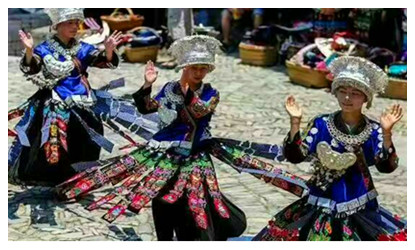 |
 |
| Morong Miao Village | |
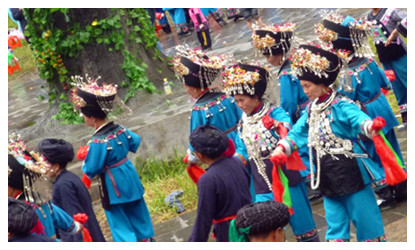 |
|
| Shanjiang Miao Village | Hangwu Miao Village |
Festivals of Miao Minority in Xiangxi
The Miao New Year Festival
Jielong Dance festival
The Flower Mountain Festival (May 5th)
The Tasting New Rice Festival (between June and July)
The Tea Picking Festival
The Girl's Day of the Miao Minority
The Sisters Festival
People of the Miao ethnic group perform a folk dance to celebrate their "Sisters Festival" on Sunday. Sisters Festival, which falls on March 15th every year in China's lunar calendar, is a traditional festival of the Miao ethnic group, and boys and girls choose their lovers on that day.
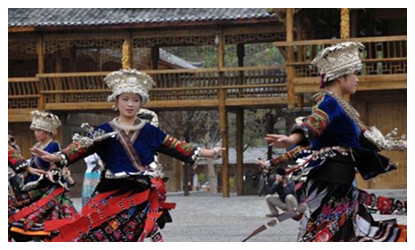 Miao Ethnic Drama
Miao Ethnic Drama
Based on the traditional folk songs and dances, Miao drama has come into being since the founding of the People's Republic of China in the residential areas of the Miao ethnic minority such as the Xiangxi Tujia autonomous prefecture in Hunan, Province, Rongshui Miao ethnic autonomous prefecture in Guangxi Province, etc.. The accompaniment musical instruments are Miao flute, Lusheng, bracket harp, and so on. The drama “Hamai Girl” is just adapted from the folk legend of the Miao ethnic group.
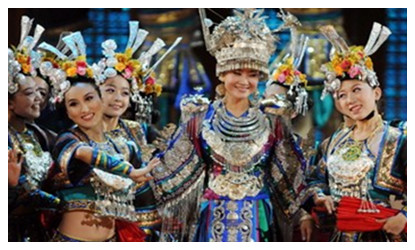 Wuling area, junction between east and west of China, is a piece of fertile land which breeds folk art. According to their contents, the Miao’s folk songs can be categorized as follows: Youfangge (love song), Jiuge (toasting song), Kuge (bitter song), Ertongge (children’s song), Zangge (song for funeral), Laodongge, Miyuge, and Shizhengge (songs of labor, riddle and current politics), each with its own distinct melody. Feige (high in tone), popular in the northeast of Guizhou Province, is a special form of folk song performance. Pange is a form where young men and women compete in an old antiphonal singing style to express their wishes and to demonstrate their talents. Generally, men start the Pange. If the man loses in the song, the woman will drive him away by splashing water, which, in Miao’s tradition, is of no malevolence but a good-willed baptism. Provided the woman answers the song fluently and both of them have feeling for each other, they may get engaged. But if the woman loses, they could still continue singing until their being engaged. On that day, woman’s parents prepare the wine in time for the prospective groom’s family to toast all the participants of the song. At last, girl’s parents, taking a pair of ox’s or ram’s horns as cups, toast the couple to be married soon. Later, the entire night participants play the Lusheng (a kind of instrument) and dance to congratulate the new couple.
Wuling area, junction between east and west of China, is a piece of fertile land which breeds folk art. According to their contents, the Miao’s folk songs can be categorized as follows: Youfangge (love song), Jiuge (toasting song), Kuge (bitter song), Ertongge (children’s song), Zangge (song for funeral), Laodongge, Miyuge, and Shizhengge (songs of labor, riddle and current politics), each with its own distinct melody. Feige (high in tone), popular in the northeast of Guizhou Province, is a special form of folk song performance. Pange is a form where young men and women compete in an old antiphonal singing style to express their wishes and to demonstrate their talents. Generally, men start the Pange. If the man loses in the song, the woman will drive him away by splashing water, which, in Miao’s tradition, is of no malevolence but a good-willed baptism. Provided the woman answers the song fluently and both of them have feeling for each other, they may get engaged. But if the woman loses, they could still continue singing until their being engaged. On that day, woman’s parents prepare the wine in time for the prospective groom’s family to toast all the participants of the song. At last, girl’s parents, taking a pair of ox’s or ram’s horns as cups, toast the couple to be married soon. Later, the entire night participants play the Lusheng (a kind of instrument) and dance to congratulate the new couple.Miao Ethnic Drum dance in Xiangxi
Miao Ethnic Drum dance in Xiangxi Autonomous Prefecture is popular among Jishou city and the counties such as Fenghuang (Phoenix), Luxi, Baojing, Huayuan, and Guzhang County. According to historical records, the drum dance, which dates back to the Han (BC 206 – CD 220) Dynasty, is said to originate from the ritual sacrifices of the Miao minority. With the passage of time the drum dance has become Miao people’s favorite dance.
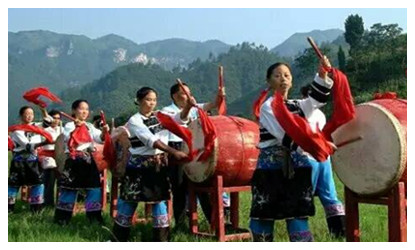
There are about ten types of drum dances, including dances of flower drum, monkey-style drum, single-woman drum, single-man drum, and group drum with a man circled by others. These folk dances are distinctive for the skillful performance of dancers and pleasant rhythms. Dancers alternatively beat the drum, joyfully jump and swing naturally.
Drum dance boasts a very long history. The drum encouraged Miao people to fight against foreign invaders and resist against the federal imperial regime. A strong national cohesion has shaped during the struggling, and the Miao drum has also become sacred to Miao people. The drum dance embodies the ethnical spirit of piety, innovation and tenacity since ancient times. The conservation and development of Miao drum dance is of profound significance to studying the history, war, religion, immigration, production and folk custom of Miao people.
Climbing Knife Ladder of Miao Minority
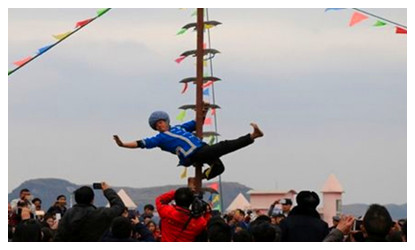 more sharp. Upon reaching the top, they place hairs on the knife and immediately their hairs are cut into two parts.
more sharp. Upon reaching the top, they place hairs on the knife and immediately their hairs are cut into two parts. The climbers on the knife ladder also need to perform games such as hanging Upside Down, roc spreading wings, Kwan-Yin Sitting in Lotus Palm Form and ancient tree twisting roots etc., use all their skills. Climbing knife ladder is soul stirring performance and a striving action as well as self-sacrificed spirits, and is made by hero, showing the past life style of Miao people. The knife ladder is also full of blood, sweat; however, the people climbing it feel the sweet and enjoy the beauty of the action.







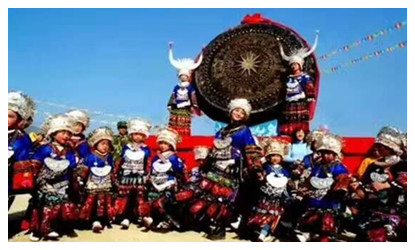
 Ask Questions ?
Ask Questions ?